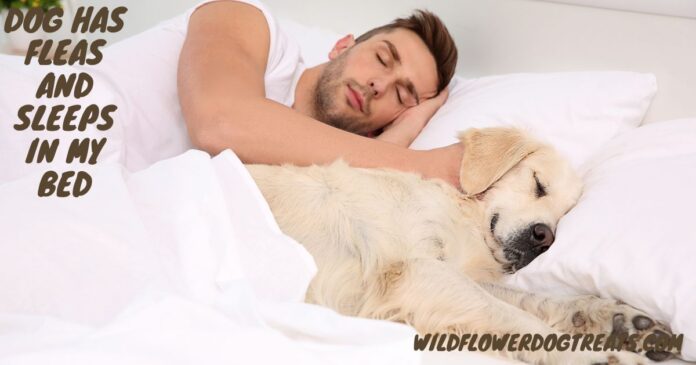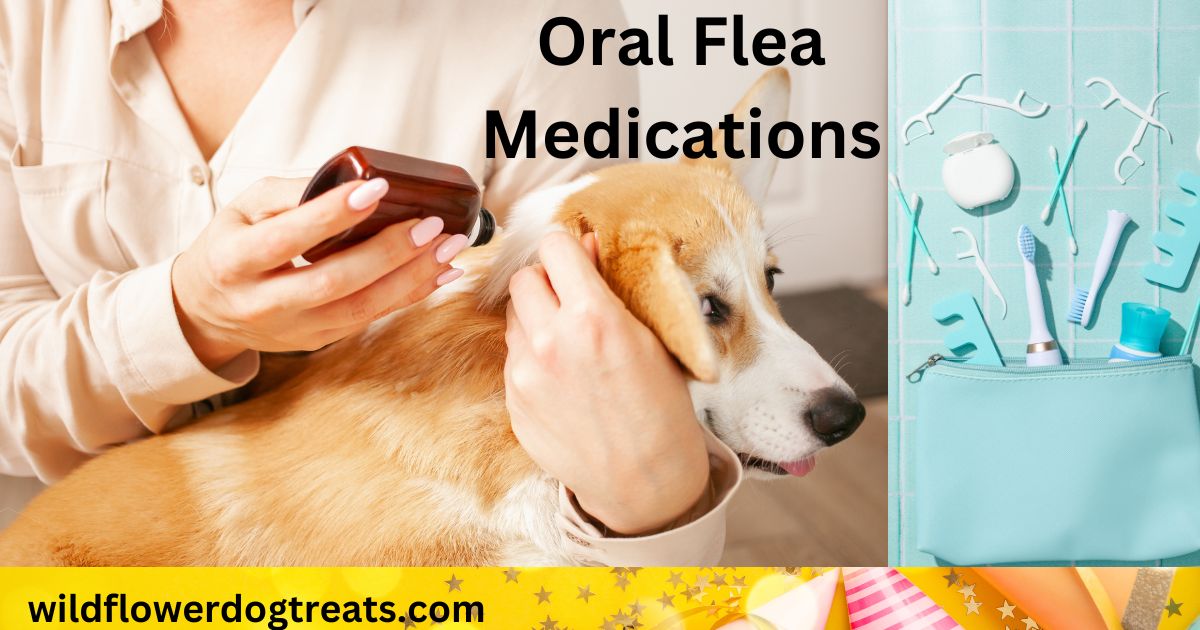Dog has fleas and sleeps in my bed, it is important to address this issue immediately for the sake of hygiene and your pet’s health. Dog with Fleas Sleeping in Bed. Fleas can not only cause discomfort and itchiness for your dog, but they can also infest your bedding and potentially spread to other areas of your home.
Taking prompt action is crucial to eliminate the fleas and prevent further infestation.
Symptoms Of Flea Infestation Inswings And Dogs
Dogs are often considered as our furry companions, bringing joy and love into our lives. However, sometimes these lovable creatures can face certain health issues, such as flea infestations. If your dog has been scratching excessively and sleeps in your bed, it may be an indication of a flea problem. Understanding the signs and symptoms of flea infestation in dogs is crucial in order to address the issue promptly and ensure the well-being of your pet.
Scratching And Itching
One of the primary signs of a flea infestation in dogs is excessive scratching and itching. Fleas are tiny parasites that feed on your dog’s blood, causing extreme discomfort and irritation. If you notice your dog constantly scratching or biting their skin, it could be a clear indication of fleas. Dog with Fleas Sleeping in Bed. Additionally, your dog may also rub itself against furniture or carpets in an attempt to relieve the itching sensation.
Red And Irritated Skin
Infected flea bites can result in red and irritated skin on your dog. These bites can lead to an allergic reaction, causing inflammation and discomfort. If you observe red spots or patches on your dog’s skin, it is important to inspect for fleas or other signs of infestation.
Visible Fleas Or Flea Dirt On The Fur
An obvious sign of a flea infestation is the presence of actual fleas or flea dirt on your dog’s fur. Fleas are small, fast-moving insects that are difficult to see with the naked eye.
However, you may notice tiny black or brown particles on your dog’s coat, which could be flea dirt. Dog with Fleas Sleeping in Bed. Flea dirt is actually flea feces, consisting of digested blood. To confirm the presence of fleas, you can use a fine-toothed flea comb and comb through your dog’s fur, especially at the base of the tail and around the ears. If you find live fleas or flea dirt on the comb, it is clear that your dog has a flea problem.
Hair Loss Or Hot Spots
In severe cases of flea infestation, dogs may experience hair loss or develop hot spots. Hot spots are areas of inflamed, red, and moist skin that can be quite painful for your dog. These hot spots can occur as a result of excessive scratching, biting, and licking, which is triggered by the presence of fleas. Dog with Fleas Sleeping in Bed. If you notice your dog’s fur thinning out or observe any bare patches of skin, it is important to address the flea infestation promptly to prevent further discomfort and potential infection.
Being attentive to the signs and symptoms of flea infestation in dogs can help you take the necessary steps to alleviate your pet’s discomfort and eradicate the problem. If your dog exhibits any of the aforementioned signs, it is recommended to consult with a veterinarian for proper diagnosis and treatment options. Dog with Fleas Sleeping in Bed. Remember, a happy and healthy dog makes for a happy pet owner!
Health Risks Associated With Fleas
Having your dog with fleas sleep in your bed can pose health risks. Fleas can transmit diseases and allergies to humans, leading to itching, skin irritations, and potential infections. It is important to address the flea problem promptly to protect your health and the well-being of your pet.
Allergic Reactions And Skin Infections
Fleas can cause a range of health issues for your dog, with the most common being allergic reactions and skin infections. Dog with Fleas Sleeping in Bed. When a flea bites your dog, it injects saliva into their skin. This saliva contains proteins that can trigger an allergic reaction in some dogs. These allergic reactions can lead to intense itching and discomfort. If your dog is constantly scratching and biting at their skin, it can result in open sores and secondary bacterial infections.
It’s important to note that not all dogs will have an allergic reaction to flea bites. Some dogs can have a high tolerance for fleas and may not show any signs of irritation. However, if your dog does have an allergic reaction, it’s crucial to address the problem promptly to prevent further complications.
Transmission Of Diseases Like Tapeworms And Bartonella
In addition to causing allergic reactions and skin infections, fleas can also transmit diseases to your furry friend. Dog with Fleas Sleeping in Bed. One common disease transmitted by fleas is tapeworm. Dogs can become infected with tapeworms when they ingest fleas that are carrying tapeworm eggs. Once inside the dog’s digestive system, these eggs hatch and develop into adult tapeworms.
Another disease that can be transmitted by fleas is Bartonella, also known as cat scratch fever. Although the name implies that it only affects cats, dogs can also contract this bacterial infection through flea bites. The symptoms of Bartonella include lethargy, fever, and swollen lymph nodes.
Anemia In Severe Cases
In severe cases, a high infestation of fleas can lead to anemia in dogs. Fleas are blood-sucking parasites, and when a large number of fleas feed on a dog, they can cause significant blood loss. Anemia occurs when the body doesn’t have enough red blood cells to carry oxygen to the tissues. This can result in weakness, pale gums, and fatigue.
If you suspect that your dog has fleas and is experiencing any of these health risks, it’s crucial to take immediate action. Dog with Fleas Sleeping in Bed. Treating the fleas and providing appropriate medical care will help alleviate your dog’s discomfort and prevent further complications.
Regularly Washing And Drying Dog Bedding
-
One of the most effective ways to combat fleas and keep your furry friend’s bedding clean is by regularly washing and drying it. Fleas can easily make their way onto your dog’s bedding, where they lay eggs and multiply. By following proper washing and drying techniques, you can eliminate these pesky insects and keep your dog’s sleeping area free from infestation.
Use Hot Water And Detergent
When it comes to washing your dog’s bedding, it is important to use hot water and a suitable detergent .Dog with Fleas Sleeping in Bed. Hot water helps to kill off fleas and their eggs, as they are highly sensitive to heat. By using hot water, you can effectively remove these pests from the bedding and prevent them from thriving. Additionally, using a detergent specifically designed for pet bedding can help eliminate any odors and bacteria that may be present.
Dry On High Heat To Kill Fleas And Eggs
After washing your dog’s bedding, the next crucial step is to dry it thoroughly. Drying on high heat is essential as it helps to kill any remaining fleas or eggs that might have survived the washing process. The high temperature of the dryer ensures that these pests are eliminated, leaving your dog’s bedding clean and free from infestation. It is important to note that air drying may not be as effective, as fleas can survive in damp environments.
Here is a simple step-by-step process to ensure the proper washing and drying of your dog’s bedding:
- Remove all visible hair and debris from the bedding.
- Place the bedding in the washing machine.
- Add a suitable amount of hot water and pet-friendly detergent.
- Select the appropriate wash cycle and let the machine do its work.
- Once the washing cycle is complete, transfer the bedding to the dryer.
- Dry on high heat for at least 30 minutes to ensure all fleas and eggs are killed.
- Remove the bedding from the dryer and inspect for any signs of remaining fleas or eggs.
- Store the clean and dry bedding in a safe place until it is time for your dog to use it again.
By following these simple steps and incorporating regular washing and drying of your dog’s bedding into your routine, you can effectively combat fleas and promote a clean and healthy sleeping environment for your furry companion.
Vacuuming And Steam Cleaning The Bed And Surrounding Areas
As a responsible pet owner, it’s crucial to frequently clean and sanitize your bed and its surrounding areas when your dog has fleas and sleeps in it. Dog with Fleas Sleeping in Bed. Vacuuming and steam cleaning are effective methods to eliminate fleas and their eggs, ensuring a hygienic resting place for both you and your furry friend.
Pay Attention To Cracks And Crevices
When vacuuming and steam cleaning the bed and surrounding areas, it’s essential to pay close attention to cracks and crevices where fleas might hide. Use nozzle attachments and steam cleaners with precision to reach these areas, allowing for thorough elimination of fleas and their larvae.
Dispose Of Vacuum Bags Properly
After vacuuming, ensure to dispose of the vacuum bags properly to prevent fleas from re-infesting the area. Seal the bags tightly before discarding, and consider placing them in a sealed plastic bag to contain any potential fleas or eggs. Dog with Fleas Sleeping in Bed. This step is crucial in preventing the spread of fleas within your living space.
Using Flea Control Products For The Bed And Bedding
If your dog has fleas and sleeps in your bed, it’s crucial to tackle the issue not only on your pet but also in your bedding. Using flea control products specifically designed for your bed and bedding is essential to prevent the spread of fleas and keep your sleeping area clean and pest-free. There are various options available for controlling fleas in your bed, including sprays, powders, and flea repellent bedding, as well as natural remedies like diatomaceous earth and essential oils.
Sprays, Powders, And Flea Repellent Bedding
When it comes to treating your bed for fleas, using specialized sprays and powders can be highly effective. These products are designed to eliminate fleas, eggs, and larvae from your bedding, providing a comprehensive solution for flea control. Additionally, investing in flea repellent bedding can create an added barrier of protection, preventing fleas from infesting your bed in the first place.
Natural Remedies Like Diatomaceous Earth And Essential Oils
For those seeking natural alternatives, diatomaceous earth and essential oils can be valuable tools in combating fleas in the bed. Diatomaceous earth, a fine powder made from the fossilized remains of diatoms, works by dehydrating and ultimately killing fleas on contact. Essential oils such as lavender, cedarwood, and peppermint have also been shown to have natural flea-repellent properties, making them suitable for use in bedding to deter fleas.
Use Of Topical Flea Treatments
The use of topical flea treatments is an effective and convenient way to rid your dog of those pesky fleas and prevent them from infesting your bed. These treatments, when applied directly to the skin, can quickly and efficiently kill fleas and provide long-lasting protection for your furry friend. However, it is important to use these treatments correctly, ensuring the proper dosage and frequency, to ensure their effectiveness and the safety of your pet.
Apply Directly To The Skin
When using topical flea treatments, it is crucial to apply them directly to your dog’s skin. This allows the medication to be absorbed and distributed effectively, targeting the fleas and breaking their life cycle. Applying the treatment on the fur or in areas where your dog cannot reach will not provide the desired results.
To apply the treatment, part your dog’s fur between the shoulder blades or at the base of their neck, ensuring that the skin is visible. Squeeze the appropriate amount of the treatment onto the skin, following the manufacturer’s instructions. Massage the area gently to spread the product and help it penetrate the skin.
Ensure Proper Dosage And Frequency
Using the correct dosage and following the recommended application frequency is essential to maximize the effectiveness of the topical flea treatment. Each treatment brand may have different instructions, so it is important to read and understand the package insert or consult your veterinarian to ensure you are using the correct amount.
Many topical flea treatments need to be reapplied monthly, but some may have different durations. Make sure to mark your calendar or set reminders to help you remember the next application. Consistency is key to keep fleas at bay and prevent them from returning to your dog and finding their way back into your bed.
It is crucial to use topical flea treatments designed specifically for dogs. Flea treatments meant for other animals, such as cats, can contain ingredients that may be harmful to dogs. Be sure to check the packaging and read the label to confirm that the product is suitable for your pet.
Now that you understand the importance of using topical flea treatments correctly, you can confidently keep those fleas away from your dog and prevent them from sharing your bed. Remember to apply the treatment directly to the skin and follow the recommended dosage and frequency. By doing so, you can enjoy a flea-free environment and a restful night’s sleep with your beloved four-legged companion.
Oral Flea Medications
When your dog has fleas and sleeps in your bed, it can be a frustrating and uncomfortable situation for both you and your furry friend. One effective solution for getting rid of these pesky parasites is through oral flea medications. These medications come in both prescription and over-the-counter options, providing you with various choices to address your pet’s flea problem.
Prescription Options
If your dog has a severe flea infestation or has underlying health issues, it is crucial to consult with a veterinarian. Your vet can prescribe oral flea medications that are specifically tailored to your dog’s needs. Prescription medications often contain more potent ingredients that can efficiently eliminate fleas and help prevent future infestations.
In addition to their stronger formulation, prescription oral flea medications also provide the advantage of being safe to use in combination with other medications. This is particularly beneficial if your dog is already on other medications or has health conditions that require additional treatments. Your vet will assess your dog’s health status and recommend the most suitable prescription option based on their unique needs.
Over-the-counter Options
For less severe flea infestations or as a preventive measure, over-the-counter oral flea medications can be an effective solution. These medications are readily available without a prescription and offer convenience to pet owners. However, it’s important to note that the efficacy of over-the-counter options may vary, so it’s crucial to choose a reputable brand that has been proven to be effective.
Before opting for an over-the-counter oral flea medication, it’s advisable to consult with your veterinarian. They can provide valuable guidance on the best choice for your dog, taking into account factors such as their age, weight, and overall health. Your vet can also help you determine the appropriate dosage for your dog, ensuring their safety and maximum effectiveness of the medication.
When choosing between prescription and over-the-counter oral flea medications, consider the severity of the flea infestation, your dog’s health status, and the advice of your veterinarian. By making an informed decision, you can effectively tackle the flea problem and provide a comfortable haven for your dog to sleep in your bed once again.
Regular Grooming And Flea Combing
Regular grooming and flea combing are essential for a dog with fleas that sleeps in your bed. By regularly grooming your dog and using a flea comb, you can effectively remove fleas and their eggs, reducing the risk of them spreading to your bed.
Remove Fleas Manually With Fine-toothed Comb
When it comes to dealing with fleas, regular grooming and flea combing are essential. These simple yet effective methods can help manage the pesky parasites and keep your dog comfortable. One of the most practical ways to remove fleas is through manual extraction using a fine-toothed comb. Start by selecting a comb specifically designed for flea removal, as its tightly spaced teeth will trap and remove the fleas from your dog’s fur. With gentle strokes, comb through your dog’s coat, paying close attention to areas where fleas commonly hide, such as the ears, armpits, and tail base.
Pay Attention To Areas Like Ears, Armpits, And Tail Base
Combat fleas with strategic grooming—focus on ears, armpits, and tail base. Regular attention to these areas removes fleas, minimizing discomfort for a happy, flea-free dog.
| Benefits | Description |
|---|---|
| Removes fleas manually | Fine-toothed comb traps and removes fleas from the fur |
| Targets flea hiding spots | Ears, armpits, and tail base are popular areas where fleas seek refuge |
| Reduces flea infestations | Regular grooming and flea combing minimize flea populations on your dog |
| Promotes comfort | Removing fleas relieves itching and discomfort for your dog |
Year-round Flea Prevention
Ensuring year-round flea prevention is vital for the health and comfort of both you and your furry friend. With the potential harm that fleas can cause, it’s essential to take proactive measures to keep these pesky parasites at bay. By implementing the right preventative techniques, you can create a safe and flea-free environment for your dog.
Use Flea Preventatives Recommended By Vets
When it comes to choosing a flea preventative for your dog, it’s best to consult with your trusted veterinarian. Vets are well-versed in the different types of preventatives available and can recommend the most suitable option for your canine companion. These medications are specially formulated to kill fleas and prevent reinfestation, ensuring that your dog stays flea-free.
There are various types of flea preventatives available in the market, ranging from spot-on treatments and oral medications to flea collars. While all of them are effective, the right choice depends on factors such as your dog’s health, age, and lifestyle. Your vet can provide personalized recommendations based on your dog’s specific needs.
Maintain A Regular Schedule For Treatment
Consistency is key when it comes to flea prevention. It’s important to maintain a regular schedule for treatment to ensure that your dog remains protected throughout the year. Flea preventatives typically need to be administered monthly, but this may vary depending on the product. By adhering to the recommended dosage and frequency, you can effectively keep fleas away and minimize the risk of infestation.
To help you stay organized, consider marking your calendar or setting reminders for your dog’s flea treatment. This will help you avoid any lapses in protection, maintaining a continuous shield against fleas. Remember, prevention is always better than dealing with the hassle and discomfort of a full-blown flea infestation.
Additionally, it’s important to treat all pets in your household for fleas simultaneously. Even if only one pet shows signs of fleas, others may be infested too. Treating all pets at the same time helps break the flea life cycle and prevents future reinfestation.
In conclusion, year-round flea prevention is crucial for keeping your home flea-free and ensuring your dog’s well-being. By using veterinary-recommended flea preventatives and maintaining a regular treatment schedule, you can provide your furry friend with a comfortable environment free from fleas.
Environmental Control Measures
Fleas can quickly infest not only your pet but also your home. Implementing environmental control measures is crucial to effectively combat fleas and prevent reinfestation. By focusing on maintaining a clean and pest-free environment, you can significantly reduce the flea population in your home.
Clean And Vacuum The House Regularly
Regular cleaning and vacuuming play a crucial role in flea control. Remove clutter and regularly vacuum floors, carpets, and furniture. Pay close attention to areas where your pet spends time, such as their bedding and favorite resting spots. After each vacuuming session, remember to dispose of the vacuum bag or empty the canister to prevent fleas from reinfesting your home.
Treat Outdoor Areas Frequented By The Dog
Since fleas can also be present in outdoor areas frequented by your dog, it’s essential to treat these spaces as well. Utilize flea treatment products specifically designed for outdoor use and apply them to areas where your pet spends time, such as the yard, patio, and any other outdoor spaces. This proactive approach can help create a flea-free environment for your pet and prevent the introduction of new fleas into your home.
Implementing these environmental control measures can help you effectively manage flea infestations and create a comfortable living environment for both you and your pet.
Regular Grooming And Hygiene Practices
Regular grooming and hygiene practices are essential to keep your dog free from fleas and maintain a healthy living environment. Consistent grooming and hygiene practices not only help in preventing flea infestations but also contribute to the overall well-being of your canine companion.
Bathe The Dog With Flea Shampoo When Needed
When dealing with a flea infestation, it’s crucial to bathe your dog with a suitable flea shampoo. Flea shampoos are specifically formulated to eradicate fleas and their eggs while being gentle on your dog’s skin. Ensure the shampoo is thoroughly massaged into your pup’s fur, paying attention to areas where fleas are likely to hide, such as behind the ears and under the legs.
Keep The Dog’s Fur Well-groomed And Trimmed
Regularly grooming and trimming your dog’s fur is an effective way to prevent and manage flea infestations. Trimmed fur minimizes the places where fleas can hide, making it easier to detect and eliminate them. Additionally, a well-groomed coat allows for better air circulation, making it less appealing for fleas to inhabit.
Consulting A Veterinarian For Severe Infestations
When it comes to dealing with a dog that has fleas and sleeps in your bed, consulting a veterinarian is crucial, especially for severe infestations. While there are various over-the-counter treatments available, some infestations may require professional intervention to ensure the health and well-being of both your dog and your home.
Diagnostic Tests For Other Health Issues
If your dog has a severe flea infestation, it’s essential to consider the possibility of other underlying health issues. Fleas can cause allergic reactions and transmit diseases, which may complicate the situation. Your veterinarian may recommend some diagnostic tests to rule out any additional health concerns. These may include:
| Diagnostic Tests | Description |
|---|---|
| Blood Test | A comprehensive blood test can help identify any abnormal blood cell counts or detect the presence of diseases transmitted by fleas. |
| Skin Scraping | A skin scraping test can determine if your dog has any underlying skin conditions caused by fleas or other parasites. |
Prescription Treatments For Stubborn Fleas
For stubborn fleas that do not respond well to conventional treatments, veterinarians may prescribe stronger medications to achieve effective results. These prescription treatments are specifically formulated to combat severe infestations and are generally more potent than over-the-counter options. Some common prescription treatments include:
- Pill-based Medications: These oral medications work by targeting fleas’ nervous systems and killing them once they bite the treated dog.
- Topical Solutions: These solutions are applied directly to your dog’s skin and provide long-lasting flea protection.
- Injectable Medications: In severe cases, veterinarians may administer injectable medications to rapidly eliminate fleas and prevent reinfestation.
Remember, each dog is unique, and the severity of the flea infestation may vary. A veterinarian will provide the most appropriate treatment options based on your dog’s specific needs and overall health condition. By seeking professional advice, you can ensure the most effective and safe course of action to rid your dog and your home of those pesky fleas.
Professional Pest Control Services
Dealing with a flea infestation can be a frustrating and troublesome experience, especially when your beloved furry friend ends up bringing those tiny pests into your bed. Not only can fleas make your dog uncomfortable, but they can also quickly spread throughout your home, infesting carpets, furniture, and even your yard. That’s where professional pest control services come in.
Treating The Entire House And Yard
When it comes to getting rid of fleas for good, it’s not enough to treat your dog alone. These resilient pests can survive in the environment, waiting to jump right back onto your pet. That’s why professional pest control services take a comprehensive approach, treating not only your dog but also your entire house and yard to eradicate the infestation completely.
Here are the key steps involved in treating the entire house and yard:
- Thorough inspection: A professional pest control expert will conduct a detailed inspection of your home to identify areas where fleas and their eggs may be hiding. This helps ensure that no spot goes unnoticed during the treatment process.
- Indoor treatment: Once the inspection is complete, the pest control technician will apply appropriate insecticides to all affected areas inside your house, including carpets, furniture, bedding, and cracks and crevices where fleas can hide.
- Outdoor treatment: To prevent re-infestation, it’s crucial to treat your yard as well. The pest control specialist will use outdoor-specific products to eliminate fleas and their larvae from your garden, patio, and any other areas where your pet spends time.
- Follow-up visits: Depending on the severity of the infestation, multiple treatment visits may be necessary to ensure the complete elimination of fleas. A professional pest control company will schedule follow-up visits to monitor the situation, re-treat if necessary, and offer guidance on long-term prevention.
Discuss Long-term Prevention Plans
Once the flea infestation has been successfully eradicated, it’s essential to take steps to prevent future outbreaks. A reliable pest control service will provide you with a long-term prevention plan tailored to your home and lifestyle. This plan may include:
- Regular pet grooming and maintenance: Keeping your pet clean and regularly using flea prevention products recommended by your veterinarian can significantly reduce the chances of another infestation.
- Vacuuming and cleaning: Regularly vacuuming your home, especially areas where your pet spends time, can help remove fleas and their eggs. Washing your pet bedding in hot water can also help eliminate any remaining pests.
- Yard maintenance: Keeping your yard well-maintained, with trimmed grass and regularly removing debris, can discourage fleas from making your outdoor space their new breeding ground.
- Consultation with a veterinarian: Seeking guidance from a veterinarian can provide valuable insights into the best preventive measures for your pet, such as using flea collars, topical treatments, or oral medications.
By following a comprehensive long-term prevention plan from a professional pest control service, you can minimize the risk of future flea infestations and ensure that your dog remains flea-free, allowing you both to enjoy peaceful nights of sleep in your bed once again.
Frequently Asked Questions On Dog Has Fleas And Sleeps In My Bed
What Are The Dangers Of Letting My Dog Sleep In My Bed?
Letting your dog sleep in your bed may lead to flea infestations, potential health hazards for both you and your pet, and disrupted sleep. It’s important to address these issues promptly to maintain a healthy and peaceful sleeping environment.
How Can I Prevent My Dog From Bringing Fleas Into My Bed?
Regular grooming, using flea preventatives, and keeping your home and yard clean are effective ways to prevent fleas from infesting your dog and subsequently entering your bed. Additionally, ensuring your dog’s bedding is regularly washed can help minimize the risk of infestation.
Can Fleas From Dogs Transmit Diseases To Humans?
Yes, fleas can transmit diseases such as bordetellosis and murine typhus to humans. Dog with Fleas Sleeping in Bed. It’s important to take preventive measures to avoid flea infestations in your home, especially in areas where your dog sleeps.
How To Properly Clean My Bed If My Dog Has Fleas?
If your dog has brought fleas into your bed, it’s crucial to wash all bedding, including pillows and blankets, in hot water. Vacuuming and using flea sprays on the mattress and bed frame can also help eliminate any remaining fleas.
Conclusion
So, if you’re dealing with a dog that has fleas and sleeps in your bed, it’s crucial to take immediate action. By addressing the flea issue, you can prevent the infestation from spreading to other areas of your home. Remember to consult with a veterinarian for effective flea treatments and regularly clean your bedding.






